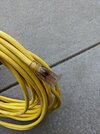I've been charging on 110 with a Costco 12awg extension cord for the past 3 months. The 2 pack 50ft yellow cords that are often on sale. I could never get more than 8a out. If I tried to go higher it would eventually drop down to 6a. The female end was always fairly warm to the touch but so was the mobile connector body so I figured that's how it was supposed to be.
Well the other night I saw another post on here showing a discolored cord. I took a look at mine and sure enough it's nice and brown. Immediately ordered a 10awg cord and I'm getting much better charging now with no warmth at all from the female end.
Don't be a statistic with melted electrical equipment. Make sure you're using the proper equipment.
Well the other night I saw another post on here showing a discolored cord. I took a look at mine and sure enough it's nice and brown. Immediately ordered a 10awg cord and I'm getting much better charging now with no warmth at all from the female end.
Don't be a statistic with melted electrical equipment. Make sure you're using the proper equipment.



